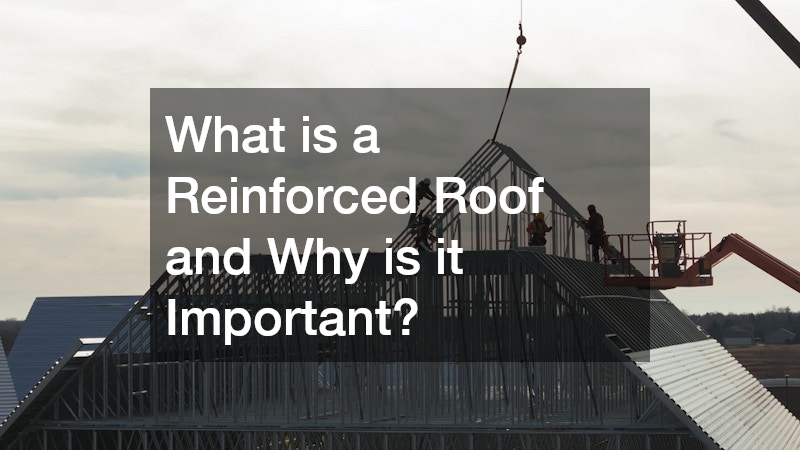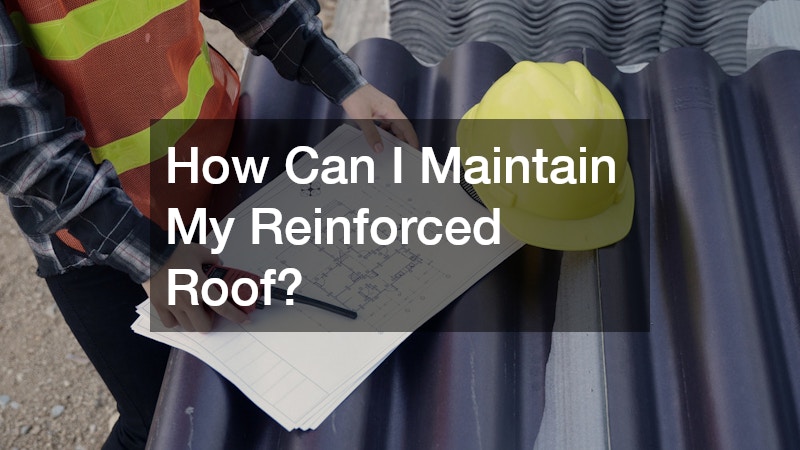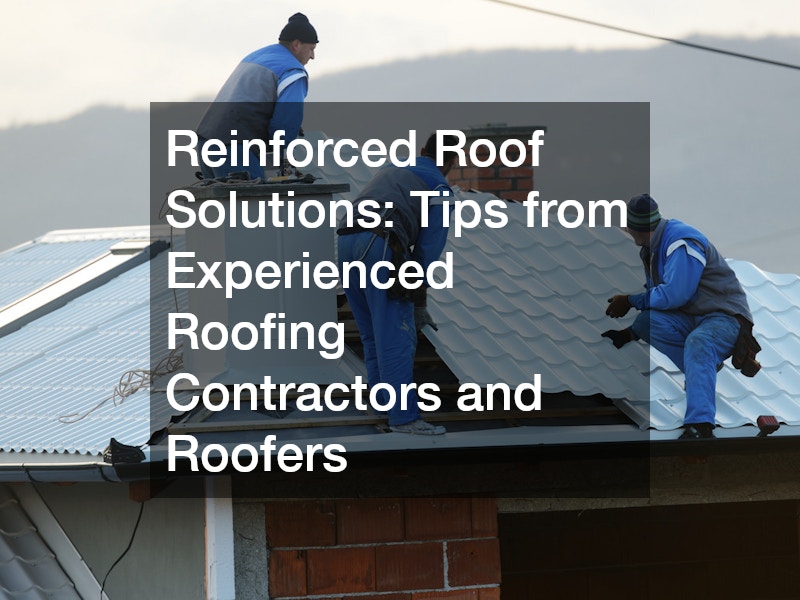Reinforced roof solutions have become increasingly important in modern construction, offering homeowners enhanced protection, durability, and energy efficiency. Unlike traditional roofing systems, reinforced roofs combine multiple layers and structural support elements to withstand extreme weather, heavy loads, and long-term wear. Roofing contractors and local roofers often recommend reinforced roofing as a long-term investment for both residential and commercial properties. These systems not only improve a home’s resilience but also contribute to aesthetic appeal and property value. Whether you are planning a new installation or considering upgrading an existing roof, understanding the benefits and best practices for reinforced roofing is essential. A roofing company can provide tailored solutions, ensuring that your reinforced roof meets both safety standards and design expectations.

What is a Reinforced Roof and Why is it Important?
Definition and Components
A reinforced roof is a roofing system that incorporates additional structural elements—such as steel beams, reinforced concrete, or synthetic fibers—to enhance strength and longevity. These components work together to distribute weight evenly, reduce the risk of damage from environmental stress, and improve overall stability. Roofing companies often integrate layers like waterproof membranes, insulation, and metal reinforcements to create a comprehensive protective system. Working with an experienced roofer ensures that each component is installed correctly, maximizing the roof’s performance and lifespan. Reinforced roofs are particularly important in areas prone to severe weather or seismic activity, providing an extra layer of security for homeowners.
Benefits of Reinforced Roofing
Reinforced roofs offer numerous advantages over standard roofing options. They provide superior resistance to wind, rain, hail, and snow, significantly reducing the likelihood of leaks or structural damage. In addition, reinforced roofing enhances durability, meaning fewer repairs and lower long-term maintenance costs. Homeowners benefit from improved energy efficiency, thanks to integrated insulation and reflective materials. A local roofing company also emphasize that reinforced roofs increase property value and appeal, offering both safety and aesthetic benefits. Furthermore, these systems often reduce noise from rain and wind, adding comfort to your living space.
Common Materials Used
Reinforced roofing systems can be constructed from a variety of materials, each selected for its specific strength and performance characteristics. Metal, concrete, and synthetic composites are common choices, often combined with waterproof membranes or insulation layers. Local roofing contractors can advise homeowners on material selection based on climate, budget, and desired aesthetics. For example, metal reinforced roofs offer longevity and resistance to corrosion, while concrete provides unparalleled structural stability. Synthetic reinforced materials, such as fiber-reinforced polymers, deliver lightweight yet durable solutions ideal for modern residential designs.
How Can Reinforced Roofing Protect My Home?
Weather Resistance
One of the primary benefits of reinforced roofing is its ability to withstand extreme weather conditions. Roofing contractors often design these roofs to resist high winds, heavy rainfall, and snow accumulation. Reinforced roofs also minimize the risk of leaks and water damage, protecting the home’s interior. Local roofers emphasize that integrating multiple layers, proper insulation, and secure fasteners enhances the roof’s performance during storms. Homeowners gain peace of mind knowing their property is better protected against unpredictable environmental factors.
Longevity and Durability
Reinforced roofing significantly extends the lifespan of a home’s roof, often lasting decades longer than standard options. Durable materials and proper installation by experienced roofers prevent premature deterioration and reduce the frequency of roof repairs. Local roofing companies recommend regular inspections to maintain durability and identify minor issues early. The combination of quality materials and professional expertise ensures the roof continues to perform under various stressors, from weather extremes to daily wear. This longevity translates into long-term savings and greater value for homeowners.
Cost-Benefit Analysis
While reinforced roofs often involve higher initial costs, the long-term benefits typically outweigh the investment. Reduced repair frequency, energy savings, and increased property value contribute to overall financial advantages. Roofing contractors can help homeowners evaluate potential return on investment when considering different reinforced roof materials and designs. Local roofers often provide detailed cost analyses, accounting for labor, materials, and expected maintenance over time. Investing in a reinforced roof may require more upfront capital, but it pays off through durability, performance, and peace of mind.
What Are the Different Types of Reinforced Roofs?
Metal Reinforced Roofs
Metal reinforced roofs are popular for their strength, longevity, and low maintenance requirements. Roofing companies often recommend galvanized steel or aluminum options for corrosion resistance. Local roofing contractors emphasize that proper installation, including secure fasteners and protective coatings, maximizes durability. Metal roofs are highly adaptable to modern home designs, providing both aesthetic appeal and superior performance. These roofs are particularly effective in areas with heavy rainfall or high winds.
Concrete Reinforced Roofs
Concrete reinforced roofs offer exceptional structural integrity and fire resistance. Local roofers often use reinforced concrete slabs or panels, combining strength with a long lifespan. Roofing contractors may include waterproof membranes and insulation layers to enhance performance. Concrete roofs are ideal for homes in extreme climates or regions prone to natural disasters. While heavier than other options, concrete provides excellent stability and protection for the underlying structure.
Synthetic Material Roofs
Synthetic reinforced roofing materials, such as fiber-reinforced polymers or composite shingles, offer lightweight yet durable alternatives. Roofing companies highlight their flexibility, resistance to cracking, and ease of installation. Local roofing contractors can customize synthetic roofs to meet aesthetic preferences and functional requirements. These materials often mimic traditional roofing styles while providing modern performance benefits. Synthetic reinforced roofs are particularly appealing for homeowners seeking energy efficiency and long-term cost savings.

How Do I Choose the Best Reinforced Roof for My Needs?
Assessing Your Climate Conditions
Climate plays a major role in determining the most suitable reinforced roofing system. Roofers evaluate local weather patterns, including rainfall, snow load, wind speed, and temperature fluctuations. Local roofing contractors provide recommendations tailored to climate-related risks. Selecting the right material and design helps prevent damage and ensures long-term performance. Homeowners in storm-prone regions may prioritize metal or concrete reinforced roofs for maximum durability.
Understanding Building Codes and Regulations
Compliance with local building codes and regulations is critical when installing a reinforced roof. Roofing companies ensure that all designs and materials meet legal and safety standards. Local roofers are familiar with permits, zoning requirements, and inspection procedures, streamlining the installation process. Adhering to regulations protects homeowners from potential fines and liability issues. Understanding these requirements before installation ensures a smooth project from start to finish.
Consultation with Professional Roofers
Professional consultation is essential for selecting a reinforced roof that meets both functional and aesthetic goals. Experienced roofing contractors assess the property, discuss material options, and provide detailed installation plans. Local roofers offer insights on maintenance, warranties, and long-term performance. Engaging professionals early in the process minimizes errors, delays, and unexpected costs. This collaborative approach ensures a tailored solution that maximizes the benefits of a reinforced roof.
What Are the Costs Associated with Reinforced Roof Installation?
Initial Installation Costs
The initial investment in a reinforced roof depends on material type, labor, and project complexity. Metal and synthetic roofs often cost less than concrete reinforced roofs, which require specialized handling. Local roofing contractors provide detailed estimates, including installation, labor, and materials. Homeowners should compare quotes from multiple roofing companies to ensure competitive pricing without compromising quality. Upfront costs may be higher, but the long-term durability justifies the expense.
Long-term Maintenance and Repair Costs
Reinforced roofs generally incur lower maintenance and repair costs compared to standard roofing systems. Routine inspections, cleaning, and minor repairs prevent significant damage. Local roofers can implement preventative maintenance schedules to extend roof life and reduce expenses. Roofing contractors may also advise on upgrading coatings or insulation to enhance performance. The combination of durable materials and proactive upkeep keeps costs manageable over time.
Warranty and Insurance Options
Most roofing companies offer warranties for reinforced roof installations, covering material defects and workmanship. Homeowners should review warranty terms carefully and understand coverage limits. Local roofers may also assist with insurance claims in case of storm or accident-related damage. Adequate insurance and warranty protection provide peace of mind and financial security. Ensuring comprehensive coverage is a critical step in responsible roof ownership.
What Are Common Issues with Reinforced Roofs?
Structural Weak Points
Even reinforced roofs can develop weak points if materials or installation are substandard. Local roofing contractors inspect for stress points, improper fasteners, or inadequate support. Roofing companies emphasize quality control during installation to prevent structural failures. Identifying and addressing weak spots early reduces the risk of costly repairs. Routine inspections are essential to maintain the roof’s integrity over time.
Impact of Harsh Weather Conditions
Extreme weather, such as hail, hurricanes, or heavy snow, can challenge reinforced roofing systems. Roofers implement design features like wind-resistant fasteners, sloped surfaces, and protective coatings. Local roofers recommend additional reinforcements in vulnerable areas. Timely inspections after storms prevent minor damage from escalating. Proper planning and professional guidance minimize weather-related risks.
Aging and Deterioration
Over time, reinforced roofing materials may experience wear due to UV exposure, moisture, or thermal expansion. Roofing contractors suggest periodic maintenance, including coating refreshes or insulation upgrades. Local roofing companies can assess aging roofs and recommend necessary repairs. Proactive upkeep slows deterioration and preserves performance. Monitoring aging components ensures the roof remains safe and functional for decades.

How Can I Maintain My Reinforced Roof?
Regular Inspections
Routine inspections allow local roofers to identify and address minor issues before they become significant problems. Roofing companies recommend semi-annual or annual assessments depending on climate and material. Early detection of leaks, cracks, or loose components extends roof longevity. Inspections also provide homeowners with peace of mind. Coordinating inspections with preventive maintenance ensures consistent performance.
Cleaning and Debris Removal
Keeping a reinforced roof clean prevents blockages in gutters, drains, and ventilation systems. Roofers remove leaves, branches, and accumulated debris that can cause water retention or structural damage. Local roofing contractors often provide professional cleaning services to ensure safety and thoroughness. Clean roofs maintain aesthetic appeal and minimize maintenance needs. Regular upkeep also reduces the risk of mold or mildew growth.
Timely Repairs and Upgrades
Prompt attention to damaged or worn sections preserves structural integrity and avoids costly repairs. Roofing companies recommend addressing minor leaks, cracks, or coating wear immediately. Local roofers may suggest material upgrades to enhance energy efficiency or durability. Keeping a maintenance log helps track repairs and anticipate future needs. Timely action ensures that reinforced roofs continue to perform optimally over their lifespan.
How Does Reinforced Roofing Impact Energy Efficiency?
Insulation and Heat Retention
Reinforced roofs often include integrated insulation layers that improve energy efficiency. Roofing contractors select materials that minimize heat transfer, keeping interiors cooler in summer and warmer in winter. Local roofers ensure proper installation to eliminate thermal bridging and energy loss. Effective insulation reduces utility bills and enhances home comfort. Homeowners benefit from a more sustainable and efficient living environment.
Reflective Coatings
Reflective coatings applied to reinforced roofs reduce solar heat absorption, lowering cooling costs. Roofing companies may use specialized paints or films to enhance reflectivity. Local roofers guide homeowners in choosing coatings compatible with roofing materials. Reflective surfaces also protect the roof from UV degradation. This simple addition extends roof life while improving energy performance.
Energy Savings Over Time
A well-maintained reinforced roof provides consistent energy savings throughout its lifespan. Efficient insulation, reflective surfaces, and proper ventilation reduce heating and cooling demands. Roofing contractors and local roofers can estimate potential savings based on material selection and design. Over time, energy-efficient reinforced roofs contribute to both financial savings and environmental sustainability. Investing in high-quality roofing materials ensures maximum efficiency benefits.

What Are the Latest Innovations in Reinforced Roofing Technology?
Smart Roofing Systems
Smart roofing systems monitor structural integrity, leaks, and energy performance in real time. Local roofers and roofing company increasingly install sensors for proactive maintenance. Data collected by smart systems allows homeowners and contractors to make informed decisions. These technologies enhance safety, efficiency, and roof longevity. Integration with home automation systems is becoming more common for modern reinforced roofs.
Eco-friendly Materials
Innovations in eco-friendly materials include recycled composites, sustainable metals, and green roofing solutions. Roofing contractors advise on options that reduce environmental impact without compromising strength. Local roofers can incorporate sustainable materials into reinforced roof designs. Eco-conscious solutions improve energy efficiency, reduce waste, and support long-term sustainability goals. Homeowners benefit from environmentally responsible yet durable roofing systems.
Enhanced Safety Features
Modern reinforced roofs include safety enhancements such as anti-slip coatings, fire-resistant layers, and reinforced anchor points for maintenance access. Local roofing companies implement these features during installation to comply with safety standards. Roofers emphasize worker safety and homeowner protection through strategic design. Enhanced safety features mitigate risks during storms, maintenance, or inspection. These improvements ensure that reinforced roofs are both functional and secure.
Conclusion
Reinforced roof solutions provide homeowners with unmatched durability, safety, and energy efficiency when installed and maintained correctly. Collaborating with experienced local roofers and roofing companies ensures that roof repair, full installation, or upgrades are executed to the highest standards. By carefully selecting materials, adhering to building codes, performing regular inspections, and implementing preventive maintenance, homeowners can maximize the lifespan and performance of their roofs. Advanced innovations, eco-friendly options, and smart roofing systems further enhance both functionality and sustainability. Establishing a relationship with a trusted roofing contractor guarantees ongoing support, timely repairs, and expert advice for future improvements. Ultimately, choosing the right professional transforms a reinforced roof from a functional necessity into a long-term investment that protects property, enhances comfort, and adds value to the home. Consistent upkeep, proactive problem-solving, and guidance from reputable local roofing contractors ensure that reinforced roofs remain resilient, safe, and aesthetically appealing for decades to come.

